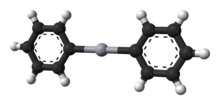 | |
 | |
| Identifiers | |
|---|---|
3D model (JSmol) | |
| ChemSpider | |
| ECHA InfoCard | 100.008.734 |
| EC Number |
|
PubChem CID | |
| UNII | |
CompTox Dashboard (EPA) | |
| |
| |
| Properties | |
| Hg(C6H5)2 | |
| Molar mass | 354.804 g·mol−1 |
| Appearance | white solid |
| Density | 2.318 g/cm3 [1] |
| Melting point | 121 to 123 °C (250 to 253 °F; 394 to 396 K) |
| Boiling point | 204 °C (399 °F; 477 K) [1] |
| slightly soluble in ethanol, diethyl ether; soluble in benzene, chloroform [1] | |
| Related compounds | |
Related compounds | |
Except where otherwise noted, data are given for materials in their standard state (at 25 °C [77 °F], 100 kPa). | |
Diphenylmercury is the organomercury compound with the formula Hg(C6H5)2. It is a white solid. [2] The compound is of historic interest as a particularly stable organometallic compound but it finds few uses because of its high toxicity.